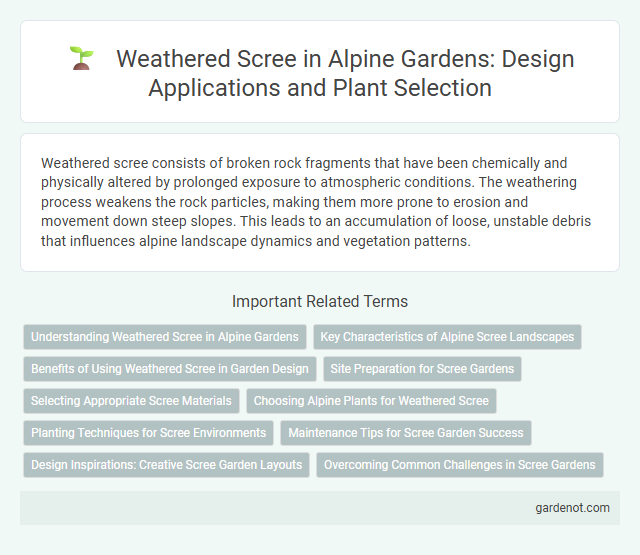Weathered scree consists of broken rock fragments that have been chemically and physically altered by prolonged exposure to atmospheric conditions. The weathering process weakens the rock particles, making them more prone to erosion and movement down steep slopes. This leads to an accumulation of loose, unstable debris that influences alpine landscape dynamics and vegetation patterns.
Understanding Weathered Scree in Alpine Gardens
Weathered scree in alpine gardens consists of fragmented rock debris that has undergone physical and chemical weathering processes, creating a unique substrate for plant growth. This weathered material improves soil drainage and mimics natural alpine habitats, promoting the establishment of drought-tolerant and hardy alpine species. Understanding the composition and behavior of weathered scree is essential for designing sustainable alpine gardens that replicate native mountainous environments.
Key Characteristics of Alpine Scree Landscapes
Alpine scree landscapes consist of loose, angular rock fragments that accumulate on steep mountain slopes due to intense weathering and frost action. These weathered scree deposits exhibit poor soil development, high porosity, and rapid drainage, creating a harsh environment for vegetation colonization. The constant rockfall and shifting substrate shape the distinctive dynamic terrain characteristic of high-altitude alpine regions.
Benefits of Using Weathered Scree in Garden Design
Weathered scree enhances garden design by improving soil drainage and reducing erosion on slopes. Its natural mineral content supports diverse plant growth and creates a rugged, aesthetically pleasing landscape. Utilizing weathered scree also minimizes maintenance by stabilizing soil and inhibiting weed development.
Site Preparation for Scree Gardens
Weathered scree provides an ideal substrate for scree garden site preparation due to its loose, well-drained composition rich in mineral content. Ensuring proper grading and removal of fine sediments enhances root penetration and prevents waterlogging in alpine plantings. Incorporating native weathered scree materials replicates natural conditions, promoting healthy growth and sustainability of scree garden ecosystems.
Selecting Appropriate Scree Materials
Weathered scree composed of fine, loose rock fragments offers superior drainage and stability for construction projects in alpine environments. Selecting scree materials with varied grain sizes, primarily consisting of angular, well-sorted particles, ensures effective compaction and reduces erosion risks. Utilizing locally sourced, weathered scree optimizes environmental compatibility and minimizes transportation impacts while maintaining structural integrity.
Choosing Alpine Plants for Weathered Scree
Alpine plants selected for weathered scree must exhibit exceptional drought tolerance and deep root systems to anchor in loose, eroded substrates. Species such as Sedum, Saxifraga, and Phlox thrive in the fragmented, mineral-rich soils typical of weathered scree environments. Their ability to withstand temperature fluctuations and nutrient-poor conditions makes them ideal for stabilizing scree slopes and enhancing biodiversity.
Planting Techniques for Scree Environments
Weathered scree presents challenging conditions for planting due to unstable, loose substrates and rapid drainage. Effective planting techniques involve selecting drought-tolerant, deep-rooted alpine species that stabilize soil and withstand temperature fluctuations. Utilizing rock mulch and carefully engineered terraces enhances moisture retention and root establishment in these dynamic scree environments.
Maintenance Tips for Scree Garden Success
Weathered scree in alpine gardens requires regular inspection to ensure proper drainage and prevent soil compaction, which can hinder plant growth. Mulching with coarse gravel helps maintain moisture levels and reduces weed proliferation, preserving the garden's natural aesthetic. Periodic removal of accumulated organic debris minimizes nutrient imbalances and supports the health of drought-tolerant alpine species.
Design Inspirations: Creative Scree Garden Layouts
Weathered scree, characterized by its multi-sized, angular rock fragments, inspires innovative scree garden layouts that mimic natural alpine environments. Designers integrate weathered scree to create visually dynamic, low-maintenance landscapes that showcase native alpine plants adapted to rocky, well-drained conditions. This approach emphasizes texture contrast and natural erosion patterns, enabling sustainable and aesthetically compelling gardens reflective of mountain ecology.
Overcoming Common Challenges in Scree Gardens
Weathered scree presents unique challenges in scree gardens due to its loose, unstable texture and poor nutrient content, which can hinder plant establishment and growth. Effective drainage management and the use of drought-tolerant, deep-rooted alpine species enhance soil stability and reduce erosion risks in weathered scree environments. Regular monitoring and amending the substrate with organic matter improve moisture retention and provide essential nutrients critical for thriving scree garden ecosystems.
Weathered scree Infographic

 gardenot.com
gardenot.com